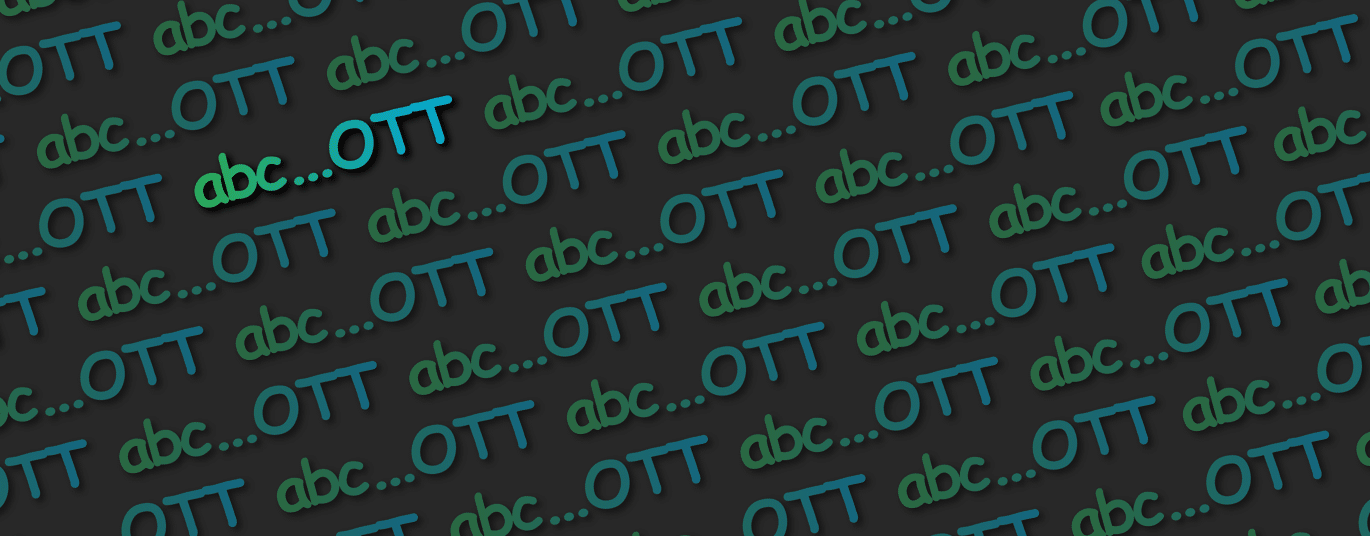What is OTT? Here is the Glossary of OTT: getting your jargon right
If you have ever wondered, what is OTT? And how is it different from IPTV? Then this glossary is for you.
CDN (or video CDN)
CDN stands for “content delivery network.” The CDN stores, or caches, the various video streams, packaged for each device format. It then streams them on-demand to connected user devices. CDN cache servers can be hosted in data centers called PoPs (Points of Presence). These are located close to end users so as to minimise delivery time, or latency. CDNs also act as a shield to protect origin servers from multiple requests. This takes the workload off the origin server. The CDN is the part of the content distribution infrastructure that needs to scale as the user base grows.
CDVR (or cloud DVR)
CDVR is a service that allows viewers on an IPTV or OTT network to record selected content for later viewing. For example, movies, shows, sports events, etc. A buffer also allows users to pause during a live stream, replay, start over, etc. Conventional DVR records programmes on a hard-disk drive inside the user’s set-top box. CDVRs, instead, record programmes in a cloud infrastructure. This results in potentially unlimited recording and access from any other device, anywhere, anytime.
CMAF (Common Media Application Format)
CMAF is a video-streaming format introduced in 2016, aiming to provide one single format for OTT content distribution. CMAF reduces network traffic and allows content distribution networks to operate with lighter CDNs. Another aim of CMAF is to reduce latency through chunked encoding: breaking the video into pieces of a shorter duration, thereby reducing the duration of the buffer so that the parts that have already been processed can be published quickly, while other parts are still being processed.
DAI (Dynamic Ad Insertion)
DAI, also known as Server-Side Ad Insertion (SSAI), refers to solutions for content and service providers to insert targeted ads in OTT streams for live, VOD and catch-up use cases. DAI workflows simplify ad delivery with a mechanism to send viewers a single live, VOD or catch-up stream that already includes stitched targeted ads. Advertising campaigns have a higher reach with DAI since ads run smoothly on a wide range of streaming devices with immunity to ad blockers. DAI also improves the user experience as ads do not buffer before playback. The inserted ads could rely on a wide range of targeting criteria including regional, per device, time based, contextual or even fully personalized / household targeting. DAI solutions are the main driver behind the significant growth of addressable advertising in the TV industry.
DRM (Digital Rights Management)
DRM refers to technologies developed to restrict the use of copyrighted material (music, movies, TV shows, etc). It ensures that only entitled viewers may display media files. These are those who have either purchased the content or subscribed to an IPTV or OTT service that lists. DRM technologies use encryption algorithms to encode the file on the server, then decode it on the user’s playback device.
EDS (embedded distribution storage)
EDS is an Ateme technology based on a hyper-converged environment. It optimizes storage and compute components to work together on a single commodity appliance. Each server embeds storage capacity. So to scale the infrastructure, an operator simply needs to add nodes to the cluster. EDS simplifies the integration between streaming and storage. It also optimizes resource usage.
FAST (Free Ad-supported Streaming TV)
A FAST channel is free, ad-supported streaming (linear) television services. The advertisement is usually inserted before the content displayed and it finances the channel. This new channel can be created from existing on-demand content catalogs (VOD or SVOD), usually reorganized as content playlists or programming grids. FAST channels are often thematic and cover niche topics such as, for example, westerns, science, history, fishing or heritage cinema, etc.
IPTV
IPTV refers to the distribution of TV content over Internet Protocol (IP) networks that are managed by a TV operator. This is in contrast to conventional terrestrial, satellite or cable formats. TV content streamed through an IPTV network can be displayed using a client media player that can be provided as software for laptops or mobile devices, or embedded in an appliance such as a connected TV or set top box. IPTV streams may carry live feeds, time-shifted media or video on demand (VOD).
Just-in-time packaging
This is what happens when the packager outputs a compatible video stream on-the-fly, when a request comes in from a user with a given playback device. Just-in-time packaging is a dynamic approach to OTT. The alternative is to generate copies of a given media ahead of time for all playback devices and store them on a server, waiting for user requests to come in. This reduces storage requirements server side and allows for future proof cloud DVR content.
Low latency
One of the challenges of OTT streaming is that the streaming protocols used to deliver video content to a multiscreen environment also add some latency to the video stream. This means that viewers will see a live event 30 or 40 seconds after it actually happened. As traditional video-delivery technologies (terrestrial, satellite, IPTV) deliver with much lower latency (typically 5 to 10 seconds), this could create a negative spoiler effect. The aim of low latency streaming is to update the streaming protocols specifications (also relying on CMAF) in order to achieve the same latency in OTT as in traditional video delivery (5 to 10 seconds).
Multiscreen TV
Multiscreen TV is a service offered by content distribution networks that allows movies and TV programs accessed by a subscriber to be displayed on a TV, as well as on any other connected user device: laptop, smartphone, tablet, game console, etc.
Some multiscreen TV services also allow registered users to log in from various locations. This means viewers may watch their programs from their homes as well as on the go, from their mobile devices, as long as they have Internet access.
Open Caching
Open Caching is a Streaming Video Alliance standard consisting mainly of a set of APIs allowing the interconnection of CDN and caching infrastructures.
It allows content owners and OTT platforms to deliver content to their subscribers with the best possible quality of experience thanks to an optimized video CDN deployed within the network of a service provider.
Origin server
An origin server holds a video collection, with one copy of each piece of original content (movies, shows, programmes, etc), ready for packaging and streaming to all user devices on request. The origin server is generally located closer to the content owner or producer.
OTT
Over-the-top (OTT) refers to a variation of IPTV distribution where users select the TV offering they want, separately from their Internet Service Provider (ISP). OTT differs from a situation where a user has only access to the TV services (a selection of channels, video on demand content and replays) offered by their ISP, generally through a proprietary set-top box connected to their cable, fibre or DSL modem. With OTT, users get their TV programs streamed by their chosen media content provider (Netflix, Amazon, Apple/iTunes, myCanal, etc) through their home Internet access and played back through a connected TV, a set-top box or even a laptop, tablet or smartphone.
Packaging
Packaging is the conversion of a video or audio file into a format that is specifically optimized for a given playback device (set-top box, mobile device, connected TV, PC, game console, etc). The stream is in the appropriate device format, for video, audio, subtitles, DRM, etc. It is also in a video resolution and sound quality that matches the device’s capabilities.
The conversion of a given media content into the right device format is done by a packager, which can be located in an origin server, where the original video or live feed is stored.
Video encoder
A video encoder receives live content streams or video files (for VOD) from a satellite, cable terrestrial or IP source and transforms them from their original format into a digital format that can be played back on various devices. The encoder delivers the transformed streams to the origin server.
Video head-end
A video head-end is a hub that takes a TV signal coming from a single intake (digital satellite, cable, terrestrial, HDMI, IP or web source) and distributes it throughout a building, over an IP, satellite, cable or wireless network. A video head-end also provides the required DRM solutions to descramble the incoming encrypted digital feeds and re-encrypt them just-in-time for secure delivery to connected TV sets and portable devices through the delivery network.
Watermarking
Digital watermarking is used to identify ownership of video content by inserting a marker embedded in the video signal.
A unique combination of markers is generated for each OTT user to verify the authenticity or integrity of the video signal source.
The final goal is to identify content leaks and to remediate by interrupting the streaming services.

